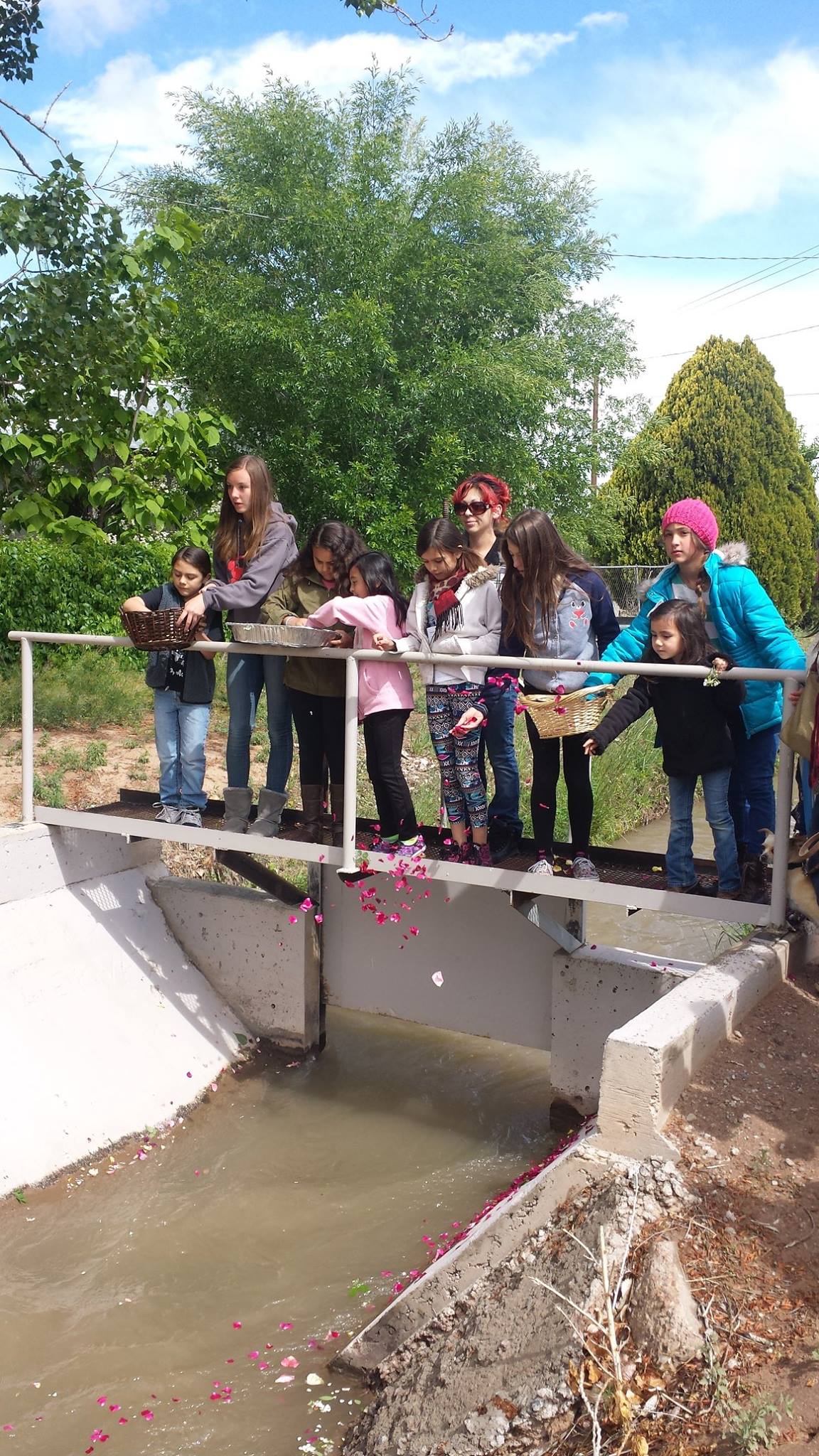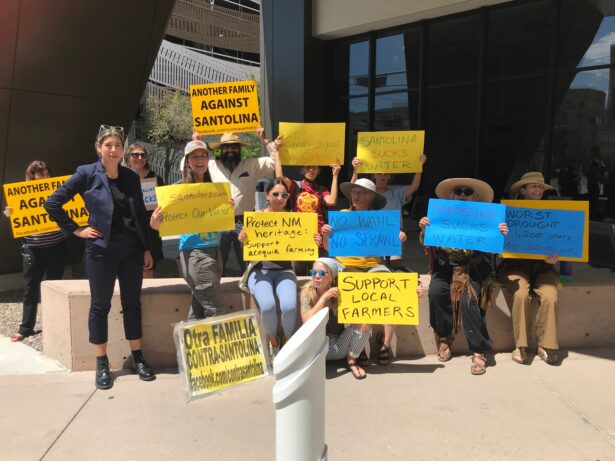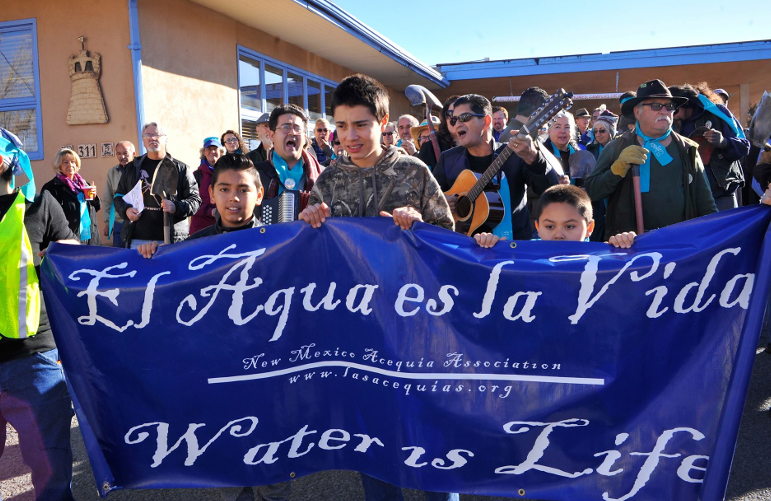This article was originally published on Waging Nonviolence.
How do we mediate our relationship with water? Those in areas with unquestioned and sufficient supply may have issues with affordability and cleanliness. But in dryer parts of the country — and the world — more fundamental challenges with the allocation of scarce water are coming increasingly to the fore.
In New Mexico, the reality of scarcity pits an Indigenous perspective of water as part of the commons against a Western worldview that is centered in a system of individual property rights. These two perspectives are colliding with ever greater intensity and higher stakes.
On the one side there is a deep history of traditional water systems, bringing wide support from the Indigenous community, local food and water supporters, and religious and environmental groups. The Pueblo in Northern New Mexico have had shared systems for water catchment for over a thousand years. Unlike most Indigenous peoples within our country’s borders, New Mexico’s 19 Pueblo communities are still on their ancestral land.
The Spanish colonists that arrived in the 1500s added their own irrigation system and spread it throughout their colonies. Originally from the Middle East, this centuries-old system is built around communally-managed irrigation ditches, or acequias. Because of this history, the Pueblo have senior water rights, so they’re the first to get water allocated, and they know its value deep in their bones.

Children take part in the blessing of the acequias by throwing petals into the water. (Facebook/Contra Santolina)
Over 600 acequias make agriculture and life possible across New Mexico. Last winter, a Bendición de las Aguas (or Blessing of the Waters) was held at the annual meeting of the stewards of this system. Each steward came with some water for the ceremony. As one of them told Source New Mexico, “We didn’t take a whole bucket because I’m sure some cow downstream needs some water.”
On the other side, developers are increasingly looking to lease water rights, and many government officials are eager to allow business and industry to freely lease all the water they want. Longtime New Mexico agricultural activist Sayrah Namaste — who works with the American Friends Service Committee, or AFSC — sees the traditional acequia system as constantly under attack, with developers coming from out of state willing to pay to lease the water rights they don’t actually possess.
This reallocation of water from low-value crop production or meadow irrigation to commercial uses — such as second-home developments, snowmaking and new suburbs — could be seen as smart economics. After all, the developers behind such efforts are willing and able to pay far more for the water than traditional small farmers. But such a perspective overlooks all the non-market-based values associated with traditional acequia communities, such as historical significance, cultural preservation, social stability and contributions to regional identity.
This regional conflict around water is embedded in a much wider and deeper struggle over the commons. Asked what we know about this struggle, we might be able to dredge up the example of the enclosure of common pastures in England, as feudal rights and obligations were being replaced by private property systems in the early stages of the Industrial Revolution. This can seem like a quaint bit of history no longer relevant in our modern world, but the concept of enclosing the commons for private use and benefit is relevant to our country’s past and very much alive today.
The whole colonization of this continent can be seen as a vast enclosure of shared Indigenous land. Over the centuries, industry has claimed a right to treat our common air and water as a private dumping ground. Currently there are threats to the commons on all fronts, as private ownership rights are asserted more and more widely. With battles raging around carbon pricing, whole forests are becoming commodities, in what some call the financialization of nature. A dizzying array of other commons are also being enclosed for private profit: cyberspace, our seed heritage, plant species, public data and even our human genome.
In New Mexico, as elsewhere, this struggle around the commons is exacerbated by climate change. Unprecedented wildfires in 2022, following many years of drought, were devastating to the state’s network of acequias, with fire or the resultant floods damaging at least 75. Calling this the “worst year on record,” a declaration from the Congresos de las Acequias states: “Acequias, once flowing with clean, crystalline snowmelt from our beloved mountains, are clogged with ash and soils that eroded from burned hillslopes. … Still, the land endures. Burned, scarred, wounded, and eroded, our beloved land is still in our care.”
Angelina Lopez, whose father grew up working on his grandparents’ farm all summer and still sees acequia irrigation as a way of life, worked three years “on the ditch” herself. The first year they were getting water every other week, which was enough. But by the last year they got water just five times during the whole growing season. “With climate change, there’s just less water to go around.”
At the same time that traditional farmers are struggling, financial interests on Wall Street are eyeing the West’s scarce water as a new investment opportunity. Water rights are seen as valuable transferrable property, to be bought and sold like land. New York-based investment firm Water Asset Management has become one of the biggest players in the field. The company’s president believes that “scarce clean water is the resource defining this century, much like plentiful, cheap dirty oil defined the last century,” and sees our country’s water as “a trillion-dollar market opportunity.”
This struggle around water is being waged on many fronts. According to Lopez, who now works for the AFSC in Albuquerque, the Middle Rio Grande Basin has only a certain amount of paper water rights — and even less “wet water.” She’s joining in a wider campaign to help people declare their water rights, so the water can stay in the valley and not be diverted to development.

Contra Santolina coalition members show support for New Mexico’s acequias. (Facebook/Contra Santolina)
Other activists, in the Contra Santolina campaign, have been pushing back for years against a big project from out of state that would basically create another city on the west side of Albuquerque — leaving no water for traditional agriculture. The Contra Santolina coalition has used every organizing tool to prevent the sprawl, including pressuring local elected officials with massive turnout at public meetings, banner drops, a tractor brigade led by farmers, media interviews, op-eds, letters from local tribes and much more.
Namaste sees water leasing as requiring a delicate balance between economic development and protection of the water in the rivers and aquifers that sustain communities. “The developers don’t understand that Western water law intersects with the acequia system” she explained. “Before you lease this water, you have to hear from the traditional people. It’s the commons.”
This winter during the state legislative session, a diverse array of New Mexicans mobilized to protect the acequia system. Rather than the outsider strategy of the Contra Santolina campaign, an insider strategy was employed to pressure state legislators to more fully support democratic water rights. The New Mexico Acequia Association, which has been patiently stitching together a wide coalition of support over many years, was able to mobilize other acequia associations, traditional farmers, the New Mexico Environmental Law Center, local agriculture groups, a tri-state family farmers union, interfaith environmental justice groups, trout fishers and other water advocates.
Together they packed hearings, made calls, and wrote over 8,000 letters. With an all-volunteer state legislature that alternates yearly between 30 and 60-day sessions, getting legislation passed can be a challenge. Nevertheless, organizers were delighted with the outcome: The session that concluded in March included a historic amount of capital funding ($12.8 million), doubling the state acequia construction fund and expanding where it can be spent.
Unfortunately, water advocates didn’t get everything they were seeking. Legislation to curb the practice of granting “preliminary approval” to developers for water leases did not pass. That means the State Engineer’s office can continue to aid industry by failing to post public notice or allow public hearings.
Despite this loss, sustained attention to the issue since 2015 has made a difference, as other arms of government have weighed in. A district court ruling in 2020 and a formal opinion by the Attorney General in January 2023 both found the practice of “preliminary approval” to be unlawful. Such high level opinions have made this industry-favorable practice legally indefensible.
If anything, the many layers of value in the acequia system are becoming more widely understood. As Lopez explains it, they maintain a human-made braided river system, spreading beauty, greenery and habitat. “Having flowing water in the desert is such a gift. You just don’t take it for granted.” What’s more, connecting with cultural heritage matters. Lopez noted that globalization increasingly brings global solutions that are not always a good fit for local conditions. Fundamentally, she sees the acequia system as a precious way of sharing water, in times of abundance or scarcity. “Ideally, it’s a water democracy.”
The fight to protect this traditional shared water system offers important lessons for all of us. We need to be aware of the promotion of “efficiency” and water marketing for the maximization of economic value, without taking into account other less easily measured values and costs. We need to broaden the definition of public interest to include the importance of water to community cohesiveness and sustainability.
Lopez offers hope “that we can hold onto this way of adapting to an arid climate and its ethos — that water is life and it’s meant to be shared.” With water becoming an ever more valuable and contested resource, we need to be crystal clear that it doesn’t belong in the private property system. It belongs in the commons.





